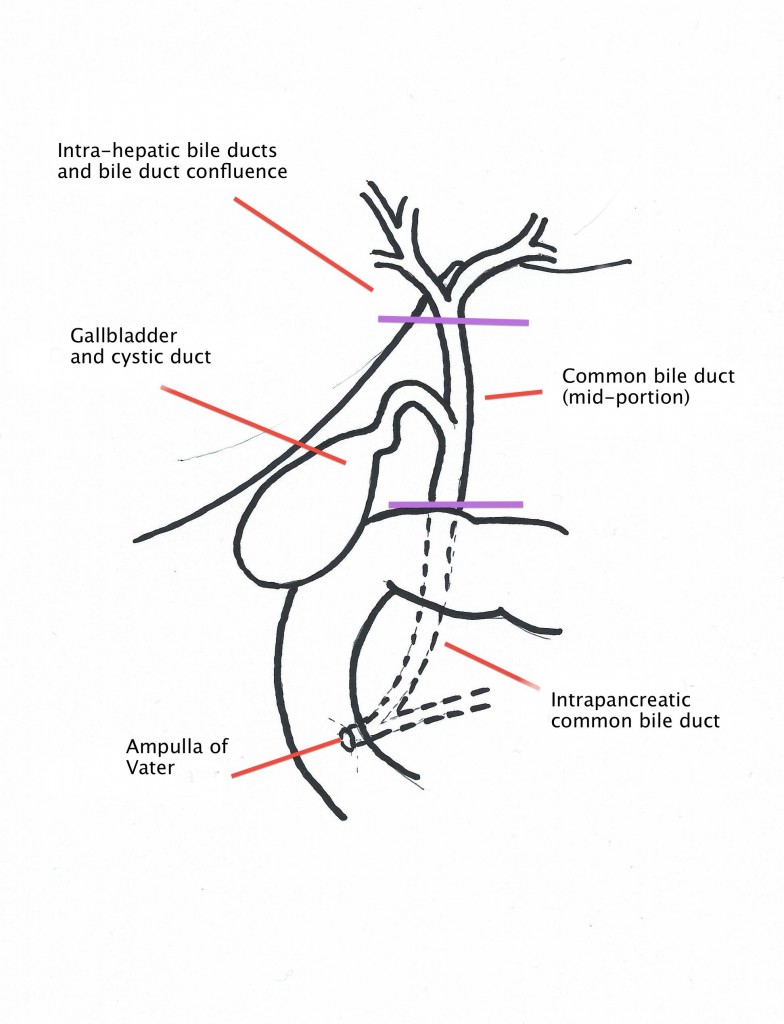Bile duct adenocarcinoma – Overview
The biliary system (Figure 1) is a tree-like system of ducts that connects the liver and gallbladder to the duodenum. The bile system allows bile, a thick liquid which is produced in the liver and stored in the gallbladder, to flow into the duodenum and help to digest fat. Bile system originates within the liver. Small tubes, similar to capillaries and called intra-hepatic bile ducts, drain bile from the cells in the liver into larger and larger branches, ending in a tube called the common bile duct or extra-hepatic bile duct. The bile duct exits the liver and drains into the duodenum. The first half of the common bile duct runs within the hepato-duodenal ligament, along with hepatic artery and portal vein; the second half runs into the pancreatic head, and joins the main pancreatic duct at the level of ampulla of Vater. The gallbladder is a reservoir that holds bile until food reaches the intestines. It is attached by a small duct, called the cystic duct, to the common bile ducts about one-third of the way down the bile duct from the liver.
Bile duct adenocarcinomas (or cholangiocarcinomas) are a group of aggressive neoplasms arising from the epithelial cells lining the bile ducts. According to their primary site, they can be split into two categories:
- Intra-hepatic cholangiocarcinoma
- Extra-hepatic (or common bile duct) cholangiocarcinoma
Extra-hepatic cholangiocarcinoma is further subdivided into three types:
- Perihilar cholangiocarcinoma (or Klatskin tumor). This neoplasm begins where left and right hepatic ducts (the two main intra-hepatic branches) join into the common bile duct at the point where it leaves the liver. This is the portion of the biliary system where neoplasms usually arise (2/3 of cases)
- Cholangiocarcinoma of the mid-common bile duct, the least common type.
- Distal cholangiocarcinoma. This type arises in the intra-pancreatic or in the periampullary tract of the common bile duct.
Primary cholangiocarcinoma is a rare disease (2500 new cases are diagnosed each year in the United States), its incidence is greater in Asia.
The principal symptoms of extra-hepatic cholangiocarcinoma are:
- Jaundice
- Weight loss
- Weakness
- Digestive problems (loss of appetite, dyspepsia)
- Pain in the upper right abdominal quadrant
Cancers that begin in the extra-hepatic bile duct usually cause jaundice, which is the yellowing of the eyes and skin caused by the buildup of bilirubin, a substace contained into the bile, in the body. When the common bile duct becomes compressed or infiltrated by the tumor, bile can’t reach the intestines, and the level of bilirubin builds up. The first sign of jaundice is darkening of the urine, which becomes brown in color. Furthermore, a person may notice their stools becoming lighter in color. When bilirubin builds up in the skin, it turns yellow and starts to itch. Of note, cholangiocarcinoma and other tumors arising in the pancreatic head and in the periampullary area, are not the most common cause of jaundice. Other causes, such as gallstones, hepatitis, and other liver diseases, are much more common. Patients with persistent obstructive jaundice are at risk of developing cholangitis, an infection of the bile duct. Characteristic symptoms include fever, chills, and abdominal pain, and in severe cases. Cholangitis may be a serious condition, associated with sepsis. When a patients presents with cholangitis, it is necessary to relieve obstruction of the bile duct placing a stent (plastic or metallic) or placing a percutaneous transhepatic biliary drainage (PTBD).
When a cholangiocarcinoma is suspected by a physician, referral to a multidisciplinary team with experience in the field is strongly advised. Estimation of the extent of disease on cross-sectional imaging (tumor staging) is the most important factor in choosing treatment options and predicting a patient’s outlook. A biopsy to be sure about the diagnosis may be also performed. For more information about the diagnostic work-up and staging of cholangiocarcinoma click here.














